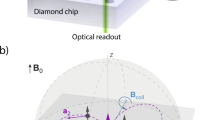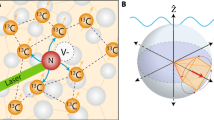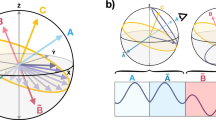Abstract
Single-molecule nuclear magnetic resonance is a current challenge in the field of magnetic resonance spectroscopy and has important applications in chemical analysis and quantum computing. Through decoherence measurements of nitrogen–vacancy centres under dynamical decoupling control, the sensing of a single 13C nuclear spin at nanometre distance has recently been realized1,2,3. A further step towards the ultimate goal of structure analysis of single molecules would be the direct measurement of the interactions within single nuclear-spin clusters4. Here we sense a single 13C–13C nuclear-spin dimer located about 1 nm from the nitrogen–vacancy centre and characterize the interaction (∼690 Hz) between the two nuclear spins. From the measured interaction we derive the spatial configuration of the dimer with atomic-scale resolution. These results indicate that, in combination with advanced material-surface engineering, central spin decoherence under dynamical decoupling control may be a useful probe for nuclear magnetic resonance single-molecule structure analysis.
This is a preview of subscription content, access via your institution
Access options
Subscribe to this journal
Receive 12 print issues and online access
$259.00 per year
only $21.58 per issue
Buy this article
- Purchase on SpringerLink
- Instant access to full article PDF
Prices may be subject to local taxes which are calculated during checkout




Similar content being viewed by others
References
Kolkowitz, S., Unterreithmeier, Q. P., Bennett, S. D. & Lukin, M. D. Sensing distant nuclear spins with a single electron spin. Phys. Rev. Lett. 109, 137601 (2012).
Taminiau, T. H. et al. Detection and control of individual nuclear spins using a weakly coupled electron spin. Phys. Rev. Lett. 109, 137602 (2012).
Zhao, N. et al. Sensing single remote nuclear spins. Nature Nanotech. 7, 657–662 (2012).
Zhao, N., Hu, J. L., Ho, S. W., Wan, J. T. K. & Liu, R. B. Atomic-scale magnetometry of distant nuclear spin clusters via nitrogen-vacancy spin in diamond. Nature Nanotech. 6, 242–246 (2011).
Degen, C. L., Poggio, M., Mamin, H. J., Rettner, C. T. & Rugar, D. Nanoscale magnetic resonance imaging. Proc. Natl Acad. Sci. USA 106, 1313–1317 (2009).
Balasubramanian, G. et al. Nanoscale imaging magnetometry with diamond spins under ambient conditions. Nature 455, 648–651 (2008).
Maze, J. R. et al. Nanoscale magnetic sensing with an individual electronic spin in diamond. Nature 455, 644–647 (2008).
Balasubramanian, G. et al. Ultralong spin coherence time in isotopically engineered diamond. Nature Mater. 8, 383–387 (2009).
Ryan, C. A., Hodges, J. S. & Cory, D. G. Robust decoupling techniques to extend quantum coherence in diamond. Phys. Rev. Lett. 105, 200402 (2010).
Staudacher, T. et al. Nuclear magnetic resonance spectroscopy on a (5-nanometre) 3 sample volume. Science 339, 561–563 (2013).
Mamin, H. J. et al. Nanoscale nuclear magnetic resonance with a nitrogen-vacancy spin sensor. Science 339, 557–560 (2013).
Maletinsky, P. et al. A robust scanning diamond sensor for nanoscale imaging with single nitrogen-vacancy centres. Nature Nanotech. 7, 320–324 (2012).
Loretz, M. et al. Radio-frequency magnetometry using a single electron spin. Phys. Rev. Lett. 110, 017602 (2013).
Huang, P. et al. Observation of an anomalous decoherence effect in a quantum bath at room temperature. Nature Commun. 2, 570 (2011).
Zhao, N., Wang, Z. & Liu, R. B. Anomalous decoherence effect in a quantum bath. Phys. Rev. Lett. 106, 217205 (2011).
Dutt, M. V. G. et al. Quantum register based on individual electronic and nuclear spin qubits in diamond. Science 316, 1312–1316 (2007).
Neumann, P. et al. Multipartite entanglement among single spins in diamond. Science 320, 1326–1329 (2008).
Fuchs, G. D. et al. Gigahertz dynamics of a strongly driven single quantum spin. Science 326, 1520–1522 (2009).
Cappellaro, P., Jiang, L., Hodges, J. S. & Lukin, M. D. Coherence and control of quantum registers based on electronic spin in a nuclear spin bath. Phys. Rev. Lett. 102, 210502 (2009).
Neumann, P. et al. Quantum register based on coupled electron spins in a room-temperature solid. Nature Phys. 6, 249–253 (2010).
Shi, F. Z. et al. Room-temperature implementation of the Deutsch-Jozsa algorithm with a single electronic spin in diamond. Phys. Rev. Lett. 105, 040504 (2010).
Xu, X. K. et al. Coherence-protected quantum gate by continuous dynamical decoupling in diamond. Phys. Rev. Lett. 109, 070502 (2012).
Sar, T. V. D. et al. Decoherence-protected quantum gates for a hybrid solid-state spin register. Nature 484, 82–86 (2012).
Dolde, F. et al. Room-temperature entanglement between single defect spins in diamond. Nature Phys. 9, 139–143 (2013).
Zhao, N., Ho, S. W. & Liu, R. B. Decoherence and dynamical decoupling control of nitrogen vacancy centre electron spins in nuclear spin baths. Phys. Rev. B 85, 115303 (2012).
Du, J. F. et al. Preserving electron spin coherence in solids by optimal dynamical decoupling. Nature 461, 1265–1268 (2009).
de Lange, G., Wang, Z. H., Riste, D., Dobrovitski, V. V. & Hanson, R. Universal dynamical decoupling of a single solid-state spin from a spin bath. Science 330, 60–63 (2010).
Kotler, S., Akerman, N., Glickman, Y., Keselman, A. & Ozeri, R. Single-ion quantum lock-in amplifier. Nature 473, 61–65 (2011).
Lange, G. de., Riste, D., Dobrovitski, V. V. & Hanson, R. Single-spin magnetometry with multipulse sensing sequences. Phys. Rev. Lett. 106, 080802 (2011).
Ofori-Okai, B. K. et al. Spin properties of very shallow nitrogen vacancy defects in diamond. Phys. Rev. B 86, 081406(R) (2012).
Acknowledgements
This work was supported by the National Key Basic Research Program of China (Grant No. 2013CB921800), the National Natural Science Foundation of China (Grant Nos. 11227901,91021005,10834005,11028510), the ‘Strategic Priority Research Program (B)’ of the CAS (Grant No. XDB01030400), the Fundamental Research Funds for the Central Universities, Hong Kong Research Grants Council (N_CUHK403/11, 402410 & HKU8/CRF/11G), the Chinese University of Hong Kong Focused Investments Scheme and the 1000 Plan Program for Young Talents. The authors thank A. Crosse for help to improve the readability of the manuscript.
Author information
Authors and Affiliations
Contributions
J.D. and R-B.L. proposed the idea. J.D. and F.S. designed the experimental proposal. P.W., X.K. and F.S. prepared the experimental set-up. F.S., F.K. and X.K. performed the experiments. J.D. supervised the set-up and experiments. N.Z. and F.S. carried out the calculation. F.S., N.Z., R-B.L. and J.D. wrote the paper. All authors analysed the data, discussed the results and commented on the manuscript.
Corresponding author
Ethics declarations
Competing interests
The authors declare no competing financial interests.
Supplementary information
Supplementary Information
Supplementary Information (PDF 896 kb)
Rights and permissions
About this article
Cite this article
Shi, F., Kong, X., Wang, P. et al. Sensing and atomic-scale structure analysis of single nuclear-spin clusters in diamond. Nature Phys 10, 21–25 (2014). https://doi.org/10.1038/nphys2814
Received:
Accepted:
Published:
Issue date:
DOI: https://doi.org/10.1038/nphys2814
This article is cited by
-
Quantum Memory on 13C–13C Dimers in Diamond with NV Centers: Simulation by Quantum Chemistry Methods
Journal of Applied Spectroscopy (2023)
-
Parallel detection and spatial mapping of large nuclear spin clusters
Nature Communications (2022)
-
Deep learning enhanced individual nuclear-spin detection
npj Quantum Information (2021)
-
Algorithmic decomposition for efficient multiple nuclear spin detection in diamond
Scientific Reports (2020)
-
Atomic-scale imaging of a 27-nuclear-spin cluster using a quantum sensor
Nature (2019)



